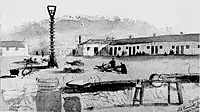William Lanne
William Lanne (also known as King Billy or William Laney; c. 1835 – 3 March 1869) was a Tasmanian Aboriginal. He is most well known as the last 'full-blooded' Aboriginal Tasmanian man.

In 1842 he was the youngest child in the last family taken to the Aboriginal camp at Wybalenna on Flinders Island by George Augustus Robinson. His native name is lost, probably because at 7 he was too young when arriving at Wybalenna and so the English name William he was given there stuck.
In 1847, he temporarily moved to Oyster Cove, and was sent to an orphanage in Hobart until 1851. In 1855 he joined a whaling ship and regularly visited Oyster Cove when he had time.
Lanne died on 3 March 1869 from a combination of cholera and dysentery.

Human remains
Following his death, Lanne's body was dismembered and used for scientific purposes. An argument broke out between the Royal College of Surgeons of England and the Royal Society of Tasmania over who should possess his remains. A member of the English College of Surgeons named William Crowther, applied to the government for permission to send the skeleton to the Royal College of Surgeons in London, but his request was denied.[1]
Nonetheless, Crowther managed to break into the morgue where Lanne's body was kept and decapitated the corpse, removed the skin and inserted a skull from a white body into the black skin.[2] The Tasmanian Royal Society soon discovered Crowther's work, and decided to thwart any further attempts to collect "samples" by amputating the hands and feet. Lanne was then buried in this state.
Because he was accused of the theft of Lanne's head (and the illicit use of another white person's head), Crowther's honorary appointment as surgeon at the Colonial Hospital was terminated. Yet in 1869, the Council of the Royal College of Surgeons awarded him a gold medal and the first Fellowship of the College ever awarded to an Australian.[1] Crowther later became Premier of Tasmania. Crowther claimed that, because Lanne had lived much of his life within the European community, his brain had exhibited physical changes, demonstrating "the improvement that takes place in the lower race when subjected to the effects of education and civilisation."[3]
Other colonists took note of Crowther's act:[4]
A fracas occurred outside the Council chamber, Hobart Town, a few nights ago. Mr. Crowther, member for Hobart Town, threatened his colleague, Mr. Kennerley, with personal violence, because of the latter's allusion to Mr. Crowther's alleged abstraction of the last aboriginal's head. Mr. Kennerley called the attention of the House to the circumstance, and Mr. Crowther was reprimanded.
— Nelson Examiner and New Zealand Chronicle, 15 August 1873
Although it is not known for certain what happened to the stolen remains of Lanne, a report in The Times in 1912 headed "Conversazione of the Royal Society: recent advances in science" mentions the exhibition of "the desiccated brain of an aboriginal Tasmanian"[5]
Several bodies of Crowther's collection were donated to the anatomy department at the University of Edinburgh. In the 1990s, the Tasmanian Aboriginal Centre believed Lanne's skull to be among them, and requested their return. The remains of Aboriginals were ultimately returned and reburied, though the university officially denied that any of the remains belonged to Lanne.[3]
Legacy
William Lanne's name is believed to be the source of the "King Billy Pine",[6] or Athrotaxis selaginoides, a native Tasmanian tree whose wood is renowned for its durability to rot and insects.
References
- David Davies, 1973 "The last of the Tasmanians" Archived 24 October 2009 at the Wayback Machine, Frederick Muller, London. 235-6)
- The Times, Saturday, 29 May 1869; pg. 9; Issue 26450; col E
- Lawson, Tom (2014). The Last Man: A British Genocide in Tasmania. I.B.Tauris. pp. 166–168. ISBN 9781780766263.
- "Tasmania". Nelson Examiner and New Zealand Chronicle. Nelson, New Zealand. 15 August 1873. p. 3.
A fracas occurred outside the Council chamber, Hobart Town, a few nights ago. Mr. Crowther, member for Hobart Town, threatened his colleague, Mr. Kennerley, with personal violence, because of the latter's allusion to Mr. Crowther's alleged abstraction of the last aboriginal's head. Mr. Kennerley called the attention of the House to the circumstance, and Mr. Crowther was reprimanded.
- The Times, Thursday, 9 May 1912; pg. 4; Issue 39894; col A : "A rather gruesome exhibit was that of Professor Elliot Smith, the desiccated brain of an aboriginal Tasmanian, believed to be the only Tasmanian brain now in existence."
- "Native Conifers of Tasmania". Parks and Wildlife Service Tasmania. 17 July 2008. Retrieved 9 August 2011.
External links
| Wikimedia Commons has media related to William Lanne. |
| Look up King Billy in Wiktionary, the free dictionary. |
| Wikisource has original text related to this article: |